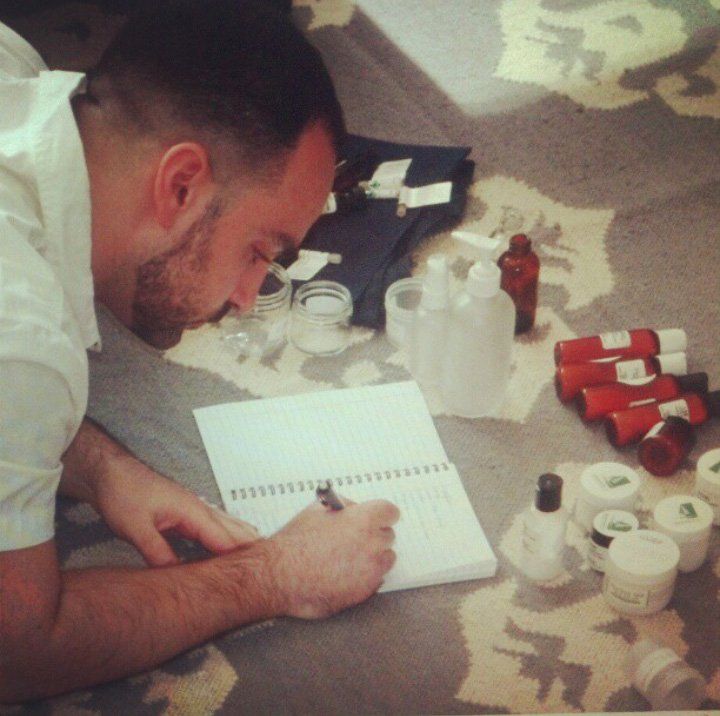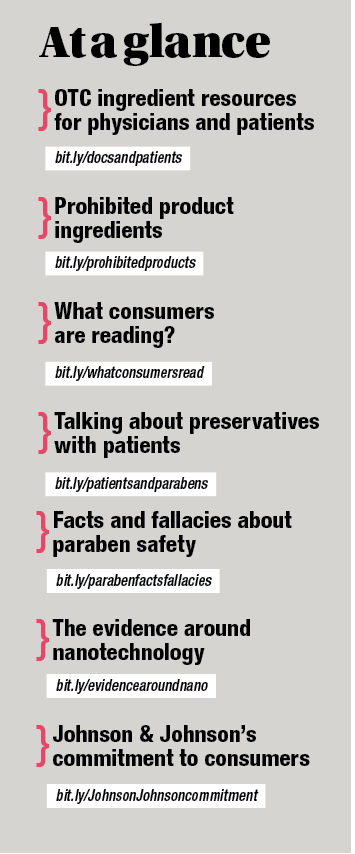- General Dermatology
- Eczema
- Chronic Hand Eczema
- Alopecia
- Aesthetics
- Vitiligo
- COVID-19
- Actinic Keratosis
- Precision Medicine and Biologics
- Rare Disease
- Wound Care
- Rosacea
- Psoriasis
- Psoriatic Arthritis
- Atopic Dermatitis
- Melasma
- NP and PA
- Skin Cancer
- Hidradenitis Suppurativa
- Drug Watch
- Pigmentary Disorders
- Acne
- Pediatric Dermatology
- Practice Management
- Prurigo Nodularis
Article
Inactive but controversial OTC product ingredients
Experts explain what we know and don’t know about some of today’s most controversial inactive OTC skincare and haircare ingredients.

Parabens. Phthalates. Chemical fragrances. Sodium lauryl sulfate. These are among the behind-the-scenes ingredients in over-the-counter skincare and haircare products that have some of the big cosmetic companies changing the way they formulate moisturizers, soaps, shampoos and anti-aging products.
But are these inactive ingredients bad or merely perceived to be bad because of misinformation or different “spins” on the truth? And are their substitutes any better?The science behind many of these controversies is often misrepresented, according to Adam Friedman, M.D., assistant professor of medicine (dermatology), physiology and biophysics at Montefiore - Albert Einstein College of Medicine, Bronx, New York.
READ: Prohibited ingredients at a glance
“You can easily find ways to demonstrate that these ingredients are toxic using the certain bench assays, but that doesn’t necessarily translate to the human body,” Dr. Friedman says.
Fears surrounding parabens and phthalates, for example, are derived from cell line studies, he says. And to compare the impact of these ingredients on a single cell type to the complexity of the human system - especially the skin, which is extraordinarily complex - is fuzzy math.
“A lot of what’s in the media about these different ingredients, causing consumers to be so concerned, is based on in vitro or cell-based assays, rather than human studies, of which there are very few. There really isn’t a lot of data out there, even in animals,” Dr. Friedman says.
Next: Take parabens, for example
Take parabens, for example
Do a Google search on parabens, which, according to the Food and Drug Administration are the most widely used preservatives in cosmetics and personal care products such as soap, shampoo, conditioner and moisturizers, and you’ll get a mix of educational and scary articles.
Parabens are preservatives that extend product shelf-life and prevent bacterial and fungal growth. Common parabens are methylparaben, ethylparaben, propylparaben and butylparaben.
It’s not always the product that’s unsafe, but rather the way it’s used, says one expert.

READ: An explanation of parabens for patients
“Parabens are very effective preservatives when used at the appropriate levels - the levels that have the toxicology data that shows they are safe,” says Laura Goodman, M.S., senior scientist, P&G Skin Care Scientific Communications.
Much of the concern comes from research that found parabens within samples of breast cancer tumors.
“The hypothesis was these chemicals can act like estrogen in the body, and, because estrogen fuels certain breast cancers, exposure could increase tumor development and progression,” Dr. Friedman says. “That sounds kind of linear and makes sense. However, these studies were unable to show a causative role (or) demonstrate a conclusive connection between paraben exposure and an increased risk of breast cancer. Furthermore, reported paraben exposure and tissue levels did not correlate with tumor location, estrogen, or any attribute of breast cancer, so it is difficult to say this anything more than a hypothesis at this point.”
Dr. Friedman says it’s easy for companies with an agenda to promote paraben-free skin and haircare products to twist the findings. But promoting parabens as cancer-causing is more propaganda than truth, he says.
NEXT: Consumer groups push for paraben-free products
While some consumer groups push for paraben-free products for general safety, they admit there’s a lot we don’t know. The Environmental Working Group (EWG) posted an article on its website, Cosmetics, Parabens, and Cancer: What Are the Facts? The lead paragraph states: “If you're confused about the potential link between parabens and cancer, you're not alone. The evidence is inconclusive and professional opinions vary widely about whether there is, in fact, a connection.”
Still, consumer demand is fueling the need for alternatives. Enter companies such as Made from Earth, which produces and sells organic skincare products online.
READ: What consumers are reading

Stergios Bekas, operations, Made From Earth“When we can, we don’t put (chemical) preservatives in our products,” says Stergios Bekas, operations, Made from Earth. “Vitamin E actually serves as a good natural preservative. … neem oil is a great natural preservative and citric acid, which comes from citrus fruit, is a great natural preservative, as well.”
But even these ingredients could be construed as harmful. Ingesting even small doses of neem oil, which is used externally as a traditional medicine in India, causes toxic effects, including seizures and renal failure, according to a Nov. 2013 paper in the Journal of the Association of Physicians in India (Meeran M, Murali A, Balakrishnan R, Narasimhan D. J Assoc Physicians India. 2013;61(11):848-85).
In the cases where the natural preservatives wouldn’t prevent bacterial growth, Made from Earth uses tetrasodium EDTA (ethylenediaminetetraacetic acid), which is a salt-based preservative, according to Mr. Bekas.
READ: Paraben facts and fallacies
“Our customers say, ‘Why do you use a preservative when we want products to be totally organic?’ There are some ingredients that if you don’t preserve them bacteria will grow…. That’s just the way it is. We would rather sell these products because they’re great for you and preserve them in the right way, as opposed to not preserve them and have them grown harmful bacteria,” Mr. Bekas says.
Jacquelyn Levin, D.O., a dermatologist in Laguna Niguel, California, says personally she uses some products containing parabens as preservatives in product formulations. Parabens, she says, do a good job of preventing bacterial and microbial growth.
“… Parabens are very easy to formulate with and create a very esthetic formula. So that is sort of the catch-22. Some of the other preservatives out there are a bit more difficult to formulate with,” Dr. Levin says.
And we don’t know if alternative preservatives are safer than parabens, she says.
“I don’t believe they have been studied the way the parabens have been studied,” Dr. Levin says. “However, we have to respect that many of our patients may be concerned with the risk of using products with parabens and its good practice to be able to offer alternatives.”
NEXT: The truth about phthalates and irritants

Phthalates
Phthalates are actually not preservatives. They’re meant to alter the feel of products. Used predominately in nail polishes, shampoos and soaps, phthalates make materials more pliable, according to Dr. Friedman.
Some fear that topical products containing phthalates can disrupt hormones, and if women use phthalates when pregnant, it could affect the fetus, Dr. Friedman says. Specifically, it has been suggested that exposure may lead to abnormal development in male infants, including low hormone levels and small genital size.
While the there’s not enough evidence to substantiate the claims, according to the FDA, many manufacturers have eliminated phthalates and consumers can choose among plenty of phthalate-free products.
Possible irritants
One thing dermatologists might see from these inactive ingredients, according to Dr. Friedman, is allergic contact dermatitis.
“Parabens and phthalates are potential allergens. And this is well-known,” Dr. Friedman says. “The incidence of allergic contact dermatitis to different agents varies, but there are great resources out there to make sense of it all, such as the American Society for Contact Dermatitis.”
Agents that create the foam or suds in most cleansers, called surfactants, can also be irritating to the skin, according to Dr. Levin.
“A great example would be sodium lauryl sulfate, which is beautifully esthetic when put in a cleanser. It has really nice foaming properties … (but) can also cause a lot of irritation. We think that it does this because it’s actually stripping the lipids and proteins that are beneficial to the skin,” Dr. Levin says.
Next: Inactives not always what they seem
Inactives not always what they seem
Ingredients in skincare aren’t always what they seem, and a lot of science goes into creating elegant formulations that are effective and safe. One example: silicone.
“People hear the word silicone and they immediately think that there’s like a barrier that you’re putting on the skin that doesn’t allow it to breathe…. That’s really not the case with silicone technology today,” Ms. Goodman says.
Silicone used in some beauty products is a feel enhancer - it gives products a smooth, velvety feel.
P&G uses silicone molecules that vary in size and are spherically shaped. The shape of the molecules helps it roll across the skin and fill different skin textures and lines, better.
“The silicone that dermatologists use to inject are very different than what we use on a topical product,” Ms. Goodman says.
The silicone ingredient is meant to sit on top of the skin but can help deliver ingredients into the skin. Silicone has been safely used in skincare products for some time, Ms. Goodman says. But it’s important that manufacturers that use silicone and other ingredients purchase high-quality ingredients.
“We have very high quality standards. I can’t guarantee that every manufacturer out there does that,” Ms. Goodman says. “Companies can match a formulation and claim they have the same ingredients but the dermatologist actually doesn’t know the quality of those ingredients. We don’t use ingredients that haven’t passed safety and toxicology evaluations … and they have to have published information on them.”
An example of an inactive ingredient that benefits the skin, according to Dr. Levin, would be ceramides, which have been shown to be lacking not only in mature skin but also in atopic skin.
“People with psoriasis are also lacking certain ceramides,” Dr. Levin says. “And what ceramides have been shown to do is that they actually help strengthen the skin and make it less susceptible to irritation and also help skin keep its own water and hydration naturally. They’re included in moisturizers and cleansers.”
On the other side of the good-bad spectrum are microbeads. Microbeads are a big topic - more because of the potential environmental impact. They don’t dissolve, according to Ms. Goodman.
In response to that concern, P&G has identified alternative technologies that are biodegradable.
“… All of our products that currently contain microbeads will be transitioned over to the new biodegradable options,” Ms. Goodman says.
P&G has already begun to use sodium bicarbonate crystals to help scrub the skin.
“Sodium bicarbonate is baking soda but it’s not the same form as the baking soda you have in your kitchen. We have a crystalized form that actually dissolves as you use it. We don’t want consumers to be over exfoliating; that’s one of the reasons it dissolves, but then, also being that it dissolves, it’s also biodegradable,” Ms. Goodman says.
Next: The mystery around fragrances
Fragrances
Fragrances are considered to be trade secrets, so their ingredients are mysteries to consumers, according to the Campaign for Safe Cosmetics. Fragrances might contain allergens and sensitizers, phthalates, neurotoxins and synthetic musks, according to SafeCosmetics.org
The potential concerns around chemical fragrances are easy to address if patients are willing to use fragrance-free products. But consumers like products with fragrance, according to Diane Foster, a consultant in the skincare industry, who works with leading skincare companies.
“A lot of times, companies are forced to include fragrance, because when they test the product, people come back to them and say they want fragrances,” Ms. Foster says. “However, good substantial, well-known companies have a panel of (chemical) fragrances that they have tested in the most sensitive skin known to mankind and found them not to be irritants.”
And some companies, including Johnson & Johnson, are eliminating perceived harmful ingredients in their fragrances.
READ: Johnson & Johnson's commitment to consumers
Another option in fragrances: essential oils, says Mr. Bekas.
“Essential oils come from the actual fruit. We use a lot of citrus oils, like orange essential oils, grapefruit essential oils. They’re a lot more expensive [because] they pretty much come from crushing a bunch of oranges down and making it a fine oil as opposed to a synthetic oil … that comes from the lab,” Mr. Bekas says.

Dr. LupoMary P. Lupo, M.D., clinical professor of dermatology, Tulane University, New Orleans, says she prefers products with natural oils, such as lavender, for a light fragrance because those give patients few problems.
But even natural fragrances are not irritant-free. And the term “unscented” can be misleading, as a masking fragrance might be used in a product, according to Dr. Lupo.
“We tend to like to see ‘non-comedogenic,’ and ‘fragrance-free’ to help guide our patients,” Dr. Lupo says.
Next: What is meant by "Organic" vs. "Natural"?
'Organic,' 'Natural': What do these terms mean?
Use of the terms organic and natural mean different things to different people and different cosmetic companies. The FDA does not define or regulate these terms, so people are free to use them as they wish.
“There are some brands out there that call themselves natural that have chemicals. Having one natural ingredient doesn’t make it a natural product,” Ms. Foster says.
READ: Alternative treatment options for acne
Dr. Lupo says “natural” does not mean low allergenicity or more effectiveness.
“It simply means, in most cases, that the active ingredient is found in nature (a plant, usually),” she says.
It’s not so much what natural and organic mean, but, rather, what they imply.
“There is this overall trend that what’s good in your diet can easily be translated to skincare, and that includes organic or natural skincare lines, non-GMO, which stands for genetically modified, as well as gluten-free,” Dr. Friedman says.
The idea, he says, is that anything that is synthetic is not good. But that doesn’t make sense, according to Dr. Friedman.
“Antioxidants, which most of these skincare lines have, are highly unstable as well as have difficulty penetrating the skin. They need ingredients to stabilize them and surfactants to help them get to where they need to go. And what about preserving them from bacterial contamination? Some skincare lines that follow the paleo diet mentality are pretty much throwing chopped fruit and proteins into a jar. That’s not going to last more than a couple of days before it gets colonized with bacteria or fungi,” Dr. Friedman says.
The biology of the gastrointestinal tract is different than that of the skin, Dr. Friedman says. Though the cell types are somewhat similar, the architecture and immune environment are different.
“While there is no question (there is) a skin-gut connection with respect to health, it’s really a poor comparison when considering interactions with topically applied or ingested materials,” he says.
That’s what makes the topical gluten-free fad curious, according to Dr. Friedman.
READ: Takeaway: Considering alternatives
In cosmetics, Triticum vulgare (wheat) gluten can be found in mascaras and skincare and haircare products. Gluten functions as a binder or a hair and skin conditioning agent. It may appear as hydrolyzed wheat gluten, Triticum vulgare (wheat) gluten, and Triticum vulgare (wheat) gluten extract on the label, all of which are huge wheat proteins. These can’t get through even an impaired skin barrier. And there have been studies in celiac patients who used a shampoo with wheat gluten extract, according to Dr. Friedman.
“So unless the consumer is eating the product, the likelihood of gluten sensitivity or inducing a flair of celiac disease is next to none,” he says.
To assume natural and organic equal safety in skincare is unfortunate, Dr. Friedman says.
“There are toxic substances on the planet that are ‘organic.’ Aflatoxin, which is derived from fungi found on peanuts, is the most carcinogenic material on the planet. Anthrax is organic. … bloodroot, an ingredient found in online moles and skin tag removal creams is an extraordinary escharotic agent. It burns right through your skin like acid,” says Dr. Friedman, who wrote a paper on the topic, published June 2012 in Journal of Drugs in Dermatology.
Poison ivy is natural, but people definitely don’t want to apply it to the skin, Dr. Levin says. The dermatologist says she tries to steer patients away from products with tea tree oil.
“I know it has antimicrobial benefits and it has a really nice cooling sensation on the skin, however there is a really high incidence of irritant in patients that use tea tree oil,” Dr. Levin says. “When people ask for an all-natural product, I do try to explain that natural ingredients can be toxic, as well, or cause irritation and allergic reaction. Then, I try and replace that with a recommendation that would be the best for their skin.”
Next: How to educate patients
Tackling the topic (with patients)
Talking with patients about the safety of controversial skincare ingredients can be a long, losing battle, if patients who are saturated with online information, according to Dr. Friedman.
“What would be useful is a centralized, database or website, where a physician could easily download a factsheet with the evidence laid out in plain English, and say these are the facts, these are the studies,” Dr. Friedman says. “I think we as dermatologists need the right tools because it’s a he-said, she-said kind of conversation.”
READ: Resources for physicians and patients
Dr. Levin says she looks for over-the-counter (OTC) skincare and haircare companies that go the extra mile and do studies showing that the products are gentle or have extra skin and hair benefits. These studies should include studies on atopic skin or even mature skin, she says.
“There are many companies out there that do that. Dove, for example, Cetaphil, CeraVe are companies that have done that kind of work,” Dr. Levin says.
Especially the bigger companies can afford to do what it takes to develop and evaluate products with safety records.
“At P&G we will not market a product until we have thoroughly evaluated each ingredient for safety. We have nearly 1,800 scientists and technicians in 16 research and development centers globally who work diligently to ensure our products are safe. We use the same science-based process to evaluate the safety of our ingredients as regulatory agencies around the world,” says Scott E. Heid, Ph.D., senior science fellow at P&G.
Dr. Lupo says she, personally, tests skincare products and has staff members do the same.
“We evaluate for efficacy, tolerability, allergy, etc.,” Dr. Lupo says.
Dermatologists who have questions about the safety of OTC product ingredients can ask. Some companies offer a direct line for dermatologists with questions. That number at P&G, for example, is 800-358-8707, or dermatologists can email pgdermatology1.im@pg.com.
Dermatologists in general should feel at ease with having patients use researched products from credible, established companies, Dr. Friedman says.
“Beyond the risk for allergic contact dermatitis, my feeling is (these ingredients) are safe,” Dr. Friedman says.
More articles in our package on OTC product ingredients:
The evidence around nanotechnology





